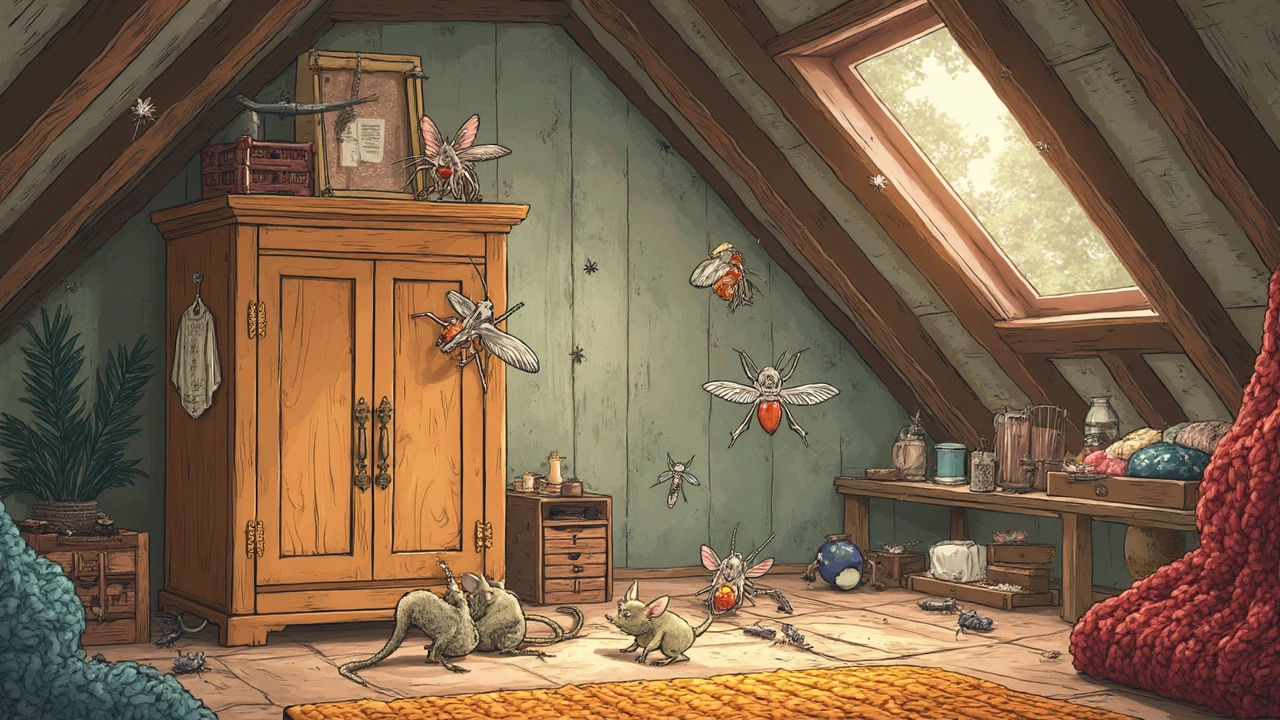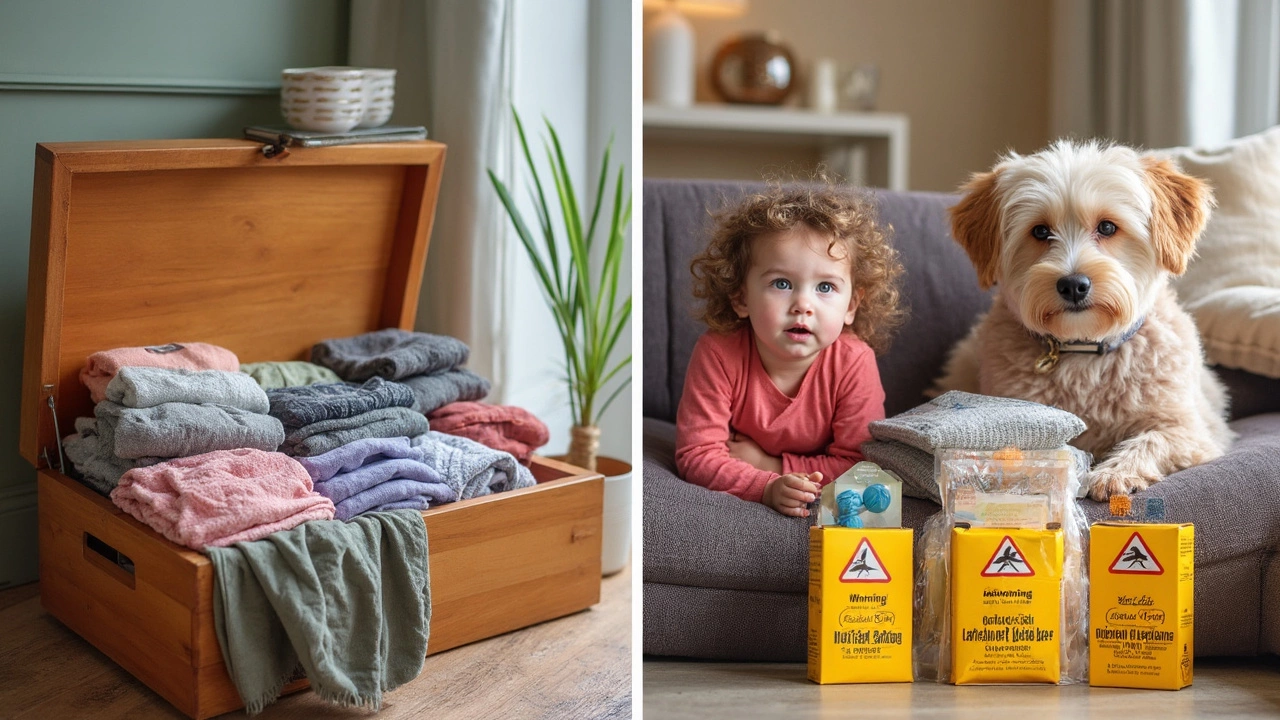If you’ve got wool sweaters stuffed in a storage bench or grandpa’s army jacket tucked inside an old cedar chest, you might wonder if mothballs are still the go-to solution for keeping pests out. Lots of folks toss a few mothballs into drawers, wardrobes, or trunks and hope for the best—but do they actually work, and what exactly are they keeping away?
Here’s the real deal: mothballs are mainly meant to repel — you guessed it — moths. More specifically, the larvae of clothes moths, which love munching on animal-based fabrics like wool, cashmere, and silk. But the story doesn’t end there. We’ll get into which other pests they affect, how they interact with the stuff in your storage furniture, and whether it’s safe to have them around kids, pets, and even the books and fabrics you want to protect.
Before grabbing a box at the store, it’s worth knowing how these stinky little balls actually work, what problems they might cause, and whether there are safer options that work just as well (or better).
- What Mothballs Really Repel
- How Mothballs Work in Storage Furniture
- Risks and Downsides You Should Know
- Safe Alternatives to Use Instead
- Smart Tips for Better Storage Protection
What Mothballs Really Repel
When it comes to keeping bugs out of your storage furniture, mothballs usually make people think of just one thing: stopping moths from chewing up clothes. That’s on point—these things were made for fighting off the larvae of clothes moths. The chemicals inside (usually naphthalene or paradichlorobenzene) put out fumes that the tiny larvae can’t stand. That’s why wool sweaters and coats stored with mothballs usually escape those nasty little holes.
Lots of folks figure that if mothballs work for one bug, they must keep away all pests—mice, roaches, even snakes. That’s the myth, but the facts tell a different story. Mothballs are targeted at a small group of pests, mainly:
- Clothes moths (the ones that eat wool, silk, and feathers)
- Carpet beetles (sometimes)
Mice, rats, roaches, silverfish, bedbugs, and spiders? Mothballs barely make a dent. There’s no proof they scare off mice for more than a few minutes, and they don’t faze roaches or other crawling bugs at all. You’re unlikely to see any change by tossing mothballs into storage furniture to keep out anything that isn’t a moth—or at best, a carpet beetle.
It’s also important to mention that the “keep everything away” trick doesn’t even work outdoors. Putting mothballs in attics, garages, or under porches is risky and usually pointless, plus it’s not what they’re meant for. Stick to using them where you’ve seen actual moth damage—or save your money for proven pest barriers.
How Mothballs Work in Storage Furniture
Mothballs don’t just sit there—they do some chemical heavy lifting. When you drop mothballs into your storage furniture, they slowly turn from solid to gas, filling that closed space with fumigant vapors. Most mothballs use either naphthalene or paradichlorobenzene. These chemicals are both toxic to insects (and, heads up, not exactly great for humans or pets either).
The science? Those vapors kill or repel the larvae of clothes moths, which are the real fabric destroyers. Adult moths aren’t the problem; it’s the tiny, almost invisible larvae that do the chewing. Mothballs work best in sealed spaces—like trunks, chests, or airtight bins. Just tossing a few in an open closet isn’t going to cut it.
Here’s a quick breakdown of how effective mothballs can be depending on your setup:
| Storage Type | Effectiveness of Mothballs |
|---|---|
| Airtight bins or sealed chests | Very effective (kills larvae) |
| Closets with doors | Somewhat effective (vapors escape) |
| Open shelves | Pretty much useless |
One big thing: if you use mothballs in your storage furniture for everyday stuff—like bedding or kids’ clothes—you really have to be careful. Those chemical vapors stick around and can leach into whatever you’re storing. It’s smart to wash anything that’s been stored this way before you use it again. Some people even report their clothes never lose the smell, no matter how much they air them out.
If you’ve got a stuffy attic trunk or some sentimental wool blankets, and you absolutely want to use mothballs, make sure the space is well sealed and away from where kids or pets can sniff, touch, or chew stuff. Oh, and remember—using too many mothballs can build up toxic fumes, so don’t overdo it hoping for extra protection.

Risks and Downsides You Should Know
Mothballs might sound harmless because people have used them for decades, but there are some pretty big downsides, especially if you’re using them in storage furniture around the house. The main ingredients—naphthalene or paradichlorobenzene—aren’t just bad-smelling. They release fumes that can be harmful to your health, especially for kids like my son Aldo, pets (I always keep Max away from closets loaded with mothballs), and anyone with breathing problems.
Let’s look at the big issues:
- Mothballs can cause headaches, nausea, dizziness, and even damage to red blood cells if inhaled over time. For babies and small children, the risks go up—a lot. The CDC says swallowing or chewing mothballs (a real risk if you’ve got curious toddlers or pets) can cause serious poisoning.
- If you put them in furniture like dressers or trunks, the strong smell clings to your stuff. Some fabrics never lose that chemical stink, not even after a few washes.
- The fumes can seep out of drawers, making nearby rooms smell weird. Worse, those fumes aren’t just about the smell—they’re toxic and can cause indoor air quality to tank.
- Using mothballs the wrong way is more common than you’d think. The EPA says you should ONLY use them in tightly sealed containers—never out in the open in closets or under beds. Most people don’t follow this, which makes the risks even bigger.
Check out these stats on the common risks from using mothballs at home:
| Issue | Details/Stats |
|---|---|
| Child Poisonings (2022, US) | Over 130 cases reported to Poison Control—mostly under age 5 |
| Pet Poisonings | Dogs and cats highly sensitive; even one mothball can cause serious illness |
| Indoor Air Quality | Paradichlorobenzene classified as a possible human carcinogen by EPA |
There’s also a big environmental problem. Tossing old mothballs outside, or letting them dissolve in the trash, puts dangerous chemicals into the soil and water. So, if you don’t want a toxic mess around your stuff or your family getting sick, it’s worth thinking twice before relying on them in your storage furniture.
Safe Alternatives to Use Instead
Mothballs might sound like the easiest fix, but they come with a bunch of downsides—strong fumes, risky chemicals, and not always the best results for everything stored inside storage furniture. Luckily, you’ve got safer choices that actually get the job done without making your stuff smell like an old attic.
Here’s a rundown of good alternatives for keeping insects at bay:
- Cedar Blocks and Chips: The scent of cedar naturally repels clothes moths and even some beetles. You can toss blocks, sachets, or even shavings into your drawers and trunks. Replace them yearly to keep the smell strong.
- Lavender Sachets: Moths aren’t fans of lavender. Fill small cloth bags with dried lavender and tuck them in your storage boxes. Bonus: things smell way better than they would with mothballs.
- Airtight Storage Bins: Moths and bugs can’t get to your clothes if they can’t reach them. Using sealed plastic bins or vacuum storage bags keeps everything safe, especially if you double-check for clean, dry fabric before packing.
- Bay Leaves: Odd but true—bay leaves chase away not just moths, but pantry beetles and some bugs, too. Stick a few in pockets or corners of your storage.
- Regular Cleaning: Most bugs look for dark, undisturbed areas full of dust and crumbs. Take everything out and clean drawers, trunks, and chests every few months to ruin their plans.
For a quick comparison, here’s how some common alternatives stack up against mothballs for use in storage furniture:
| Option | Keeps Moths Away | Safe for Pets/Kids | Requires Replacement? | Odor Issues |
|---|---|---|---|---|
| Mothballs | Yes (mainly moths) | No | Yes | Strong, chemical |
| Cedar | Yes | Yes | Yes (every 1-2 yrs) | Fresh, woody |
| Lavender | Yes (mild) | Yes | Yes (every 6 months) | Pleasant, floral |
| Airtight Plastic | Yes (creates barrier) | Yes | No | Odorless |
| Bay Leaves | Yes (mild) | Yes | Yes (check yearly) | Spicy, herbal |
If you want to keep things simple, go with cedar and airtight containers. They’re safe even if you’ve got kids like Aldo or a nosy pet—trust me, Max sniffed the cedar but didn’t even bother with it. If you want your closet or chest to actually smell nice and fresh, lavender is a win too. Forget about mothballs unless you have a specific pest emergency—and definitely don’t use them around food, pets, or curious toddlers.

Smart Tips for Better Storage Protection
If you want your stuff to last and don’t want to rely on mothballs, it’s time to get smart about storage. Most pests, like moths and silverfish, show up where there’s a mix of clutter, moisture, and food crumbs. Tackling those issues keeps them away way better than any chemical ball ever could.
First rule: clean before you store. Moths and bugs are drawn to dirt, sweat, and food bits on clothes and bedding. So, always wash and dry items before packing them up. For furniture, wipe everything down—especially inside drawers and corners, which love to hide crumbs and dust.
- Use airtight containers. Plastic bins with tight lids keep bugs out and block humidity, which ruins fabrics and attracts pests.
- Try natural repellents. Cedar blocks, lavender sachets, or even dried rosemary throw moths and other insects off without harsh chemicals. Replace them every 3-6 months.
- Don’t overpack. Air needs to move so moisture doesn’t build up inside your storage furniture. If things feel damp, add some silica gel packs—they’re cheap, safe, and super effective for keeping stuff dry.
- If you’re storing valuable clothes for a season, pick garment bags made of fabric instead of plastic. Fabrics breathe better and stop mold from forming.
- Check your stuff about once a month. Just a quick look keeps you ahead of any bug problems before they turn into holes-in-your-favorite-sweater nightmares.
Wondering what prevention steps work best head-to-head? Here’s a quick reality check with a few facts and stats:
| Protection Method | Average Lifespan for Clothing Protection | Pest Repellent Effectiveness (%) |
|---|---|---|
| Airtight Plastic Bins | 2+ years | 95 |
| Cedar Blocks/Sachets | 3-6 months per refill | 80 |
| Lavender Sachets | 3-4 months per refill | 75 |
| Mothballs | 6-12 months | 86 |
Don’t overlook regular cleaning and keeping things clutter-free. That single step can cut your pest risk by half. If you’ve got kids or pets (like Max, my golden retriever, who’ll sniff at anything), stick with non-toxic solutions and pull out the vacuum when you change out seasonal clothes. These simple moves keep pests out, fabrics fresh, and your storage furniture in good shape for years.







